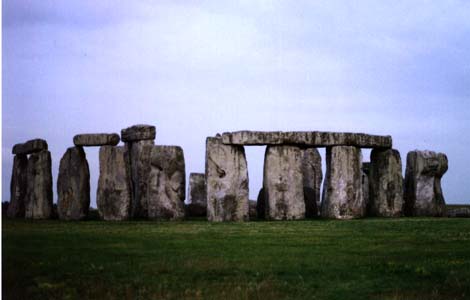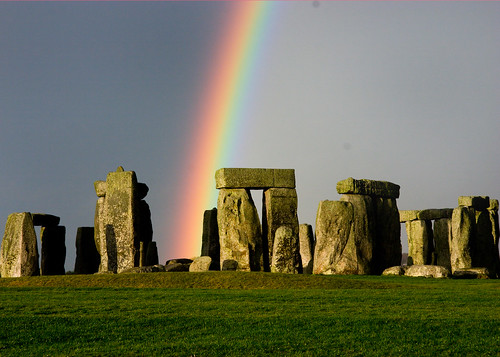
Dünyanın en ünlü prehistorik yapılarından biri ve İngilterenin ulusal ikonu sayılan Stonehenge gizem, güç ve dayanıklılık simgesidir.Bugün bizler için Stonehenge’nin ne amaçla yapıldığı hala tartışmalı , bu konuda bir çok görüş vardır.Kimilerine göre bir tapınak olan Stonehenge çok güçlü bir iddiaya göre prehistorik dönem önemli göksel olayları işaretlemek için kullanılan bir gözlemevidir.

İngiltere’de Salisbury yakınlarında bulunan Stonehenge Neolitik çağdan kalma , iç içe çemberler içine dizilmiş dikine taş bloklardan oluşur.Görenleri hayrete düşüren bu yapının en şaşırtıcı yanı ilk evresinin 5.000 yıl önce yapılmaya başlanmış olmasıdır.Gerçi daha sonraki yüzyıllarda yol ve ev yapımı için taşlar yerinden sökülerek tahrip edilmiş olsada görkemini hala korumaktadır.Yapımı çok fazla zaman, emek ve sabır gerektirmiştir.Bunun için Stonehenge bugün mühendislik harikası olarak kabul edilmektedir.Bu ilginç yapıyı kimlerin yaptığı tam olarak bilinmemektedir.Druidler, Eski Yunanlılar, Fenikeliler yada Romalılarca yapılmış olabileceği düşünülmektedir.Tartışmaların diğer yoğunlaştığı bir konu ise gökbilimle olan ilgisidir.

1919 ‘dan itibaren yapılan çalışmalar Stonehenge’nin üç evrede tamamladığı ortaya koymaktadır.İlk evre (Sto 1) neolitik çağda , M.Ö 3100-2300 yılları arasında tamamlanmıştır.Yapı alanı , ortasında bir hendek bulunan yuvarlak bir dış setle çerçevelenmiştir.Hendeğin geyik boynuzundan yada tahtadan yapılmış küreklerle kazıldıldığı düşünülüyor.İç tarafta hendek boyunca sıralanan 56 çukur bulunur.Bu çukurları 17.yy ‘da John Aubrey bulduğundan , aynı isimle anılır.Setin kuzey doğu giriş yolunda Heel Stone denilen 35 tonluk kumtaşından bir blok bulunur.

M.Ö 2100-2000 yılları arasında tamamlanan ikinci evrede (Sto 2) sete giriş yolu olan Avenue , doğudaki Avon Irmağına kadar 3 km uzatılmıştır.Ayrıca iç içe , eş merkezli iki çemberi oluşturan kaya bloklarıda bu evrede dikilmiştir.İç çemberi oluşturan kaya bloklarıda bu evrede dikilmiştir.İç çemberi oluşturan göz taşları galler’in güneybatısındaki Prescelly Dağlarından getirilmiş.Yaklaşık 225 km’lik yolun bir bölümünde taşlar , sallarla denizden , geri kalan kısmıysa insanların yada yük hayvanlarının çektiği kütükler üzerinde taşınmış.Bu taşların her birinin 4 ton ağırlığında olduğu ve 80 kadar taş bulunduğu düşünülürse, bu yolculuğun epeyce zahmetli geçtiği anlaşılır.
Avenue ve göztaşlarının konumu Güneş’in yaz gündönümündeki doğuşuna göre ayarlanmıştır. Bu ikinci evrede çift çember tamamlanmadan bırakılmış ve sonraki evrelerde taşlar yerlerinden sökülerek tekrar kullanılmıştır.Girişte bulunan 35 ton ağırlığındaki Heel Stone’un da bu evrede dikilidiği düşünülür.Bu taşın konumu çok eski çağlarda insanların gökbilime ilgilerinin bir göstergesi sayılabilir.Yaz gün dönümünde (21 Haziran) çemberin ortasında oturan biri Güneş’in Heel Stone’un tam üstünden doğduğunu görebilir.

Yapımına MÖ 2000′de başladığı düşünülen üçüncü evrede kendi içinde üçe ayrılır. Stonehenge 3a’da her biri 9 m uzunluğunda ve 50 ton ağırlığındaki taş bloklarla daha küçük çemberler oluşturulmuştur.Bu düşey olarak dizilen taşların üzerine konulan yatay bloklarla, çembere kesintisiz bir görünüm verilmiştir.Bu halkların içinede iki düşey ve bunların üzerine yatay olarak konulmuş bir üçüncü taştan oluşan üçlü taş bloklardan beşi , at nalı biçiminde dizilmiştir.Dış yüzeyleri çok düzgün bir biçimde yontulan bu taşlar özenle biçimlendirilmiştir. Arkeolojik ipuçları bu ince işciliğin yunanistandaki Miken ve giritteki Minos uygarlığıyla ilişkilerini desteklemektedir.
Bu 80 kadar iri blogun taşınmasıda pek kolay olmamıştır.Bunlarda 30 km kuzeyindeki Marlborough Downs’dan getirilmiştir.Göz taşlarının taşındığı yola göre daha kolay sayılan rotada Redhorn Tepesi önemli bir engel olmuştur.Bugün , tek bir blokun böyle bir engelden geçirilebilmesi için 600 kişiye gereksinim duyulabileceği düşünüşüyor.
Daha snraki evrede göztaşı bloklar yontularak düzeltilmiş ve elips biçiminde sıralanmıştır.En son evredeyse bir önceki evrede yapılan elips biçiminde sıralanmıştır.En son evredeyse (sto 3) bir önceki evrede yapılan elips bozulmuş , bu taşlarla Stonehenge 2′nin artakalan blokları bir çember ve bir at nalı oluşturacak biçime yeniden düzenlenmiştir.Ayrıca bu evrede , yapının çevresinde eş merkezli iki çember oluşturacak biçimde Y ve Z çukurları çılmıştır.
Stonehenge gibi eski yapıların hangi tarihte yapıldığının saptanmasıda arkeolojik çalışmanın bir bölümünü oluşturur.Tarihleme için en sık başvurulan yöntemlerden biride radyokarbon yöntemidir.Stonehenge evrelerinin kronolojik sırasının saptanması içinde radyokarbon tarihleme yönteminden yararlanılmıştır.Tümüyle disiplinlerarası bir işbirliği gerektiren bu çalışmada ,arkeologlar ,kimyagerler,paleoçevreciler ,fizikçiler ve istatistikçilerden oluşan uzamanlar , yapının kendisinden alınan ve çevresinden toplanan örnekler üzerinde çalışmıştır
Stonehenge is a prehistoric, mysterious circle of upright stones in southern England. Construction on the great monument began 5,000 years ago; the famous stones that still stand today were put in place about 4,000 years ago.
The great age, massive scale and mysterious purpose of Stonehenge draw over 800,000 visitors per year, and several thousand gather on the summer solstice to watch the sunrise at this ancient and mystical site.
The stones are aligned almost perfectly with the sunrise on the summer solstice, and it is almost unquestioned that Stonehenge was built as a spectacular place of worship.
Although the faith of the Stonehenge builders predates any known religion, the site has become a place of pilgrimage and worship for Neopagans who identify themselves with the Druids or other forms of Celtic paganism. It is also popular with New Age devotees, who report powerful energies at the site.
History
The current site, awe-inspiring as it is, is only part of the original Stonehenge. The original construction has suffered a great deal from both weather damage and human pillage of its rock over the millenia.
Stonehenge has been the subject of much archaeological and scientific inquiry and research, especially in the last century. The modern account of the construction of Stonehenge is based primarily on excavations done since 1919 and especially since 1950.
Archaeologists believe the construction of the site was carried out in three main stages, which have been labeled Stonehenge I, Stonehenge II and Stonehenge III.
Stonehenge I
The native Neolithic people of England began construction of Stonehenge I by digging a circular ditch using deer antlers as picks. The circle is 320 feet in diameter, and the ditch itself was 20 feet wide and 7 feet deep.
Next, they used the chalky rubble taken from the ditch to built a steep bank circle just inside the outer circle. Inside the bank circle, they dug 56 shallow holes known as the Aubrey holes (named after their discoverer, 17th century scholar John Aubrey).
Finally, two parallel stones were erected at the entrance to the circle, one of which, the Slaughter Stone, still survives. Also surviving are two Station Stones, positioned across from each other on opposite sides of the circle, which may also have been erected during this time. Stonehenge I seems to have been used for about 500 years and then abandoned.
Stonehenge II
Construction of Stonehenge II began around 2100 BC. In this phase, a semicircle of granite stones known as bluestones (from their original coloring) was assembled within the original bank and ditch circles. Several aspects of this phase are intriguing.
First, the bluestones come from the Preseli Mountains in South Wales, nearly 250 miles away. There were about 80 of them, weighing up to 4 tons each. How they were transported is not known, although scholars don't regard the feat as impossible and various theories have been presented.
It is intriguing to wonder, however, what makes the Stonehenge site so special that so much effort would be expended to drag the giant stones 250 miles instead of constructing the monument near the quarry.
Second, the entranceway to the semicircle of bluestones is aligned with the midsummer sunrise. The alignment was continued by the clearing of a new approach to the site, "The Avenue," which has ditches and banks on either side like the original outer circle. Two Heel Stones (so-named from the shape of the one that remains) were placed on the Avenue a short distance from the circle (and, today, very close to Highway A344).
Stonehenge III
Stonehenge III is the stone circle that is still visible today. During this phase, which was started in about 2000 BC, the builders constructed a circle of upright sarsen stones, each pair of which was topped with a stone lintel (horizontal capstone). The lintels are curved to create a complete circle on top.
There were originally 30 upright stones; 17 of these still stand. These stones came from the Marlborough Downs, 20 miles to the north, are 7 feet tall and weigh 50 tons each. The outside surfaces of all these stones were pounded smooth with hammers, and dovetail joints fasten the lintels to their uprights.
Within this stone ring was erected a horseshoe formation of the same construction, using 10 upright stones. Here the trilithons (set of two uprights plus the lintel) stand separated from one another, in 5 pairs. Eight of the original ten stones remain. The horseshoe shape opens directly towards the Slaughter Stone and down the Avenue, aligned with the summer solstice sunrise.
About a century later, about 20 bluestones gathered from Stonehenge II were placed in a horseshoe shape inside the sarsen horseshoe. Less than half of these remain. Some shuffling around of the bluestones and digging of holes (probably in preparation for placing the bluestones, which was not completed) occurred around 1500 BC. The Altar Stone is the biggest of these newly-arranged bluestones that remains. Around 1100 BC, the Avenue was extended all the way to the River Avon (over 9,000 feet from Stonehenge), indicating that the site was still in use at that time. |